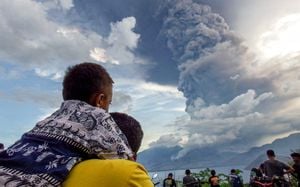The South Asian air pollution crisis is rapidly intensifying, particularly affecting cities like Delhi and Lahore, where severe smog has triggered emergency responses from government authorities.
On November 15, 2024, residents of Lahore and Multan faced dire conditions as Punjab's provincial government declared health emergencies due to deteriorated air quality. Maryam Aurangzeb, the senior minister, underscored the urgent health risks posed by high pollution levels, which led to the temporary closure of educational institutions and public spaces like parks and zoos. Restaurants were only allowed to operate until 4 PM, and all construction activities were halted to help mitigate the environmental damage.
Meanwhile, Delhi was not spared from the dangerous air quality; the city's Air Quality Index (AQI) hit 425, indicating hazardous conditions. According to the World Health Organization, such levels are categorized as "severe," posing health risks to all, particularly vulnerable groups like children, the elderly, and those suffering from respiratory ailments. Schools announced remote learning, and the government imposed strict restrictions on vehicle types allowed within the city limits, emphasizing the rise of private and commercial diesel and petrol vehicles contributing to air pollution.
The situation compelled authorities to implement emergency measures, such as banning non-essential construction and restricting the entry of trucks and buses to the city. On the first day of enforcing these measures, Delhi's Traffic Police collected fines exceeding Rs 1 crore (about $121,000) from violators of the city's pollution-control laws.
Air quality deteriorated significantly as the Diwali festival unfolded, known for its fireworks and outdoor celebrations, which typically translate to increased pollution. The spike was compounded by traditional crop-burning practices still prevalent across the northern regions of India, where farmers use the method to clear land for new crops following harvest season. This agricultural practice is prevalent particularly during the time of year when Delhi's air quality turns severe.
On the tourist front, Nainital, located about 300 kilometers away from Delhi, saw a surge of visitors fleeing from the polluted metropolitan area. Known for its serene landscapes and improved air quality, Nainital recorded only 30 µg/m³ of PM2.5 pollutants on Friday, representing significant respite compared to the hazardous levels affecting other cities. Tourist attractions were abuzz with guests enjoying the scenery and engaging with local culture.
Locals and business owners rejoiced about the increased tourist traffic resulting from nearby cities escaping hazardous air. Hotels reported high occupancy rates as travelers sought temporary refuge from the choking smog settling over urban environments. Visitors flocked to famed spots like Snowview, the Zoo, and Naini Lake, eager to embrace the fresh air and natural beauty.
Back within Punjab, the air pollution crisis is drawing urgent calls for action from both regional leaders and health officials. Though the initial responses prioritized immediate health concerns, experts warn more effective long-term strategies are needed. These could include investment in cleaner technologies and stricter emission regulations on industries contributing to air quality degradation.
Health authorities are advocating for the implementation of public awareness campaigns on pollution's severe health effects, urging people to minimize outdoor exposure, especially during high pollution days. Hospitals report rising cases of respiratory issues, affirming the dire need for systematic interventional measures to improve public health outcomes.
Across the entire South Asia region, there is growing recognition of air pollution as not just a local challenge but as one of the most pressing environmental crises affecting millions. Researchers have noted the correlation between systemic air pollution and declining public health, linking compromised air quality to long-term health repercussions such as chronic respiratory diseases and reduced life expectancy.
The air pollution crisis is not merely confined to major urban centers. Increasingly, rural areas also face deteriorated air quality due to industrial growth and agricultural practices. The encroachment of urban development is pushing the boundaries of metropolitan populations, requiringsimultaneous action at governmental and public levels to advocate for sustainable practices.
Given these circumstances, experts call for collaborative efforts among neighboring countries like India and Pakistan to address shared environmental challenges. Joint initiatives—encompassing regulatory reforms, emission control, and showcasing best practices—could be beneficial for both countries as they grapple with reducing pollution levels and safeguarding citizens’ health.
This dire timeline of events outlines how intertwined environmental health and public welfare security have become across South Asia. Without decisive and immediate action, these current states of crisis may transform from troubling headlines to entrenched societal norms.
Local governments, NGOs, and citizens must unite to push back against deteriorative air conditions and prioritize the health of their communities.



